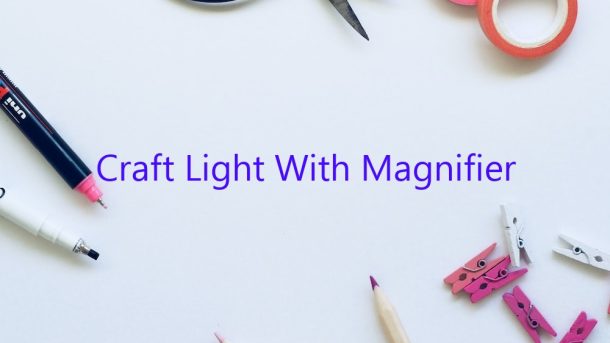A magnifying glass is a simple optical instrument that is used to enlarge the apparent size of an object. It is a type of lens that produces a magnified image of an object. Magnifying glasses are often used to read small print, and to do intricate work such as sewing and jewelry making.
There are many different types of magnifying glasses, but the most common type is the simple magnifying glass that has a single lens. This type of magnifying glass is also called a loupe. A magnifying glass with multiple lenses is called a microscope.
Magnifying glasses are usually made of glass, but they can also be made of plastic. The glass or plastic is usually curved to help focus the light and the image. The lens of a magnifying glass is usually round, but it can also be oval or rectangular.
The magnification of a magnifying glass is the ratio of the size of the image to the size of the object. A magnifying glass with a magnification of 10x will produce an image that is 10 times larger than the object.
Magnifying glasses are used for a variety of purposes, including:
-Reading small print
-Doing intricate work such as sewing and jewelry making
-Detecting pests or diseases on plants
-Viewing small objects such as stamps, coins, or jewelry
Contents
What is the best magnifying glass for crafts?
When it comes to magnifying glasses for crafts, there are a few things you need to consider. The most important factor is the size of the magnifying glass. The larger the glass, the more detail you will be able to see.
If you are looking for a magnifying glass to use for detailed work, such as needlepoint or embroidery, you will need a glass that is at least 5x or 6x magnification. For general craft work, a 3x or 4x magnification should be sufficient.
Another important factor to consider is the type of lens. Some magnifying glasses have a fixed lens, while others have a zoom lens that can be adjusted. A zoom lens is more versatile, as it can be used for a variety of tasks.
The final factor to consider is the type of light source. Some magnifying glasses come with their own built-in light, while others require an external light source. If you need a magnifying glass for use in low-light conditions, you will need one with a built-in light.
When choosing a magnifying glass for crafts, it is important to consider the size of the glass, the type of lens, and the type of light source. The 5x or 6x magnification is best for detailed work, while the 3x or 4x magnification is good for general craft work. The type of lens is important to consider if you need a magnifying glass for use in low-light conditions. The type of light source is important to consider if you need a magnifying glass with a built-in light.
What is an illuminated magnifier light used for?
An illuminated magnifier light is a device that uses a lens to magnify an image. It is often used to help people see clearly when they are reading or doing other tasks that require close attention to detail. Illuminated magnifier lights typically have a built-in light that helps to illuminate the magnified image, making it easier to see.
There are a variety of different illuminated magnifier lights on the market, and each one is designed for a specific use. Some illuminated magnifier lights are small and handheld, while others are larger and designed to be mounted on a desk or work surface. Some magnifier lights are designed specifically for use with reading materials, while others can be used to magnify images or text from a variety of different sources.
Illuminated magnifier lights can be a valuable tool for people with vision problems, or for anyone who needs to see clearly when working on small tasks. They can help to improve the clarity of an image and make it easier to see detail. Illuminated magnifier lights are also helpful for people who are visually impaired or have low vision.
What is the best magnifying glass for an elderly person?
When it comes to magnifying glasses, there are a few things to consider when choosing the best one for an elderly person. The main things to look for are size and power.
Larger magnifying glasses are generally easier for older adults to use, as they provide a larger viewing area. Additionally, it is important to choose a magnifying glass with a high power rating, as this will provide a sharper image.
There are a number of magnifying glasses on the market that meet these requirements, and it is important to find one that is comfortable for the individual to use. Some magnifying glasses have adjustable lenses or light attachments, which can be helpful for those with vision problems.
Ultimately, the best magnifying glass for an elderly person is one that is easy to use and provides a clear, sharp image. There are a number of different magnifying glasses available to meet these needs, so it is important to do some research to find the best one for the individual.
What is a good magnifier?
What is a good magnifier?
There is no definitive answer to this question as what makes a good magnifier for one person may not be ideal for another. However, there are a few factors to consider when choosing a magnifier.
The first consideration is the size of the magnifier. Generally, the larger the magnifier, the easier it is to see details. However, a large magnifier can be difficult to carry around and may not be suitable for close up work.
Another factor to consider is the power of the magnifier. A magnifier with a higher power will be able to enlarge details more. However, it is important to note that a magnifier with a high power can also be more difficult to use and can cause eye fatigue.
Finally, it is important to consider the type of magnifier. There are a few different types of magnifiers, each with its own advantages and disadvantages. For example, a hand-held magnifier is easy to use but does not provide a lot of magnification. Conversely, a magnifying glass provides more magnification but can be difficult to use for detailed work.
Ultimately, the best magnifier for you depends on your needs and preferences. Consider the size, power and type of magnifier before making a purchase.
How do I choose a magnifying lamp?
When it comes to magnifying lamps, there are a lot of factors to consider. In this article, we’ll go over the different types of magnifying lamps and what to look for when choosing one.
The first thing to consider is the type of magnifying lamp. There are three main types: desk lamps, clamp lamps, and floor lamps. Desk lamps are perfect for small tasks, while clamp lamps can be attached to a table or countertop. Floor lamps are ideal for larger tasks.
Next, you’ll need to decide on the magnification power. The magnification power determines how large the object will appear when magnified. Most magnifying lamps have a magnification power of between 2.5X and 10X.
Another important factor to consider is the type of light. Some magnifying lamps have incandescent light, while others have fluorescent light. Incandescent light is more natural and provides better color contrast, while fluorescent light is more efficient and lasts longer.
Finally, you’ll need to consider the cost. Magnifying lamps vary in price, but you can find one that fits your budget.
When choosing a magnifying lamp, consider the type of lamp, the magnification power, the type of light, and the price.
How much magnification does a miniature painting need?
How much magnification does a miniature painting need?
This is a question that has been asked by many miniature painters over the years. The answer, of course, depends on the individual painting and the level of detail desired. However, a good starting point is to use a magnification of at least 100x.
At 100x magnification, even the smallest details in a miniature painting will be visible. This level of detail is necessary if you want to create a truly realistic painting. Without it, the miniature may look unfinished or ‘sketchy’.
Some painters prefer to use a higher magnification, particularly if they are painting small details such as eyes or hair. However, it is important to be careful not to go too far, as too much magnification can make it difficult to see the overall composition of the painting.
In general, a magnification of 100x is a good starting point for miniature paintings. It will allow you to capture the smallest details while still retaining a sense of realism and proportion.
What are the two main functions of a magnifying lamp?
A magnifying lamp is a device that uses a lens to make an object or text appear larger. This can be useful for tasks such as reading, sewing, or inspecting small objects. Magnifying lamps come in a variety of shapes and sizes, and can be handheld or mounted to a table or other surface.
There are two main functions of a magnifying lamp: magnification and illumination. Magnification is the process of making an object or text appear larger, while illumination is the process of providing light to see clearly. A magnifying lamp can perform both of these functions, or it can focus on one or the other.
There are many different types of magnifying lamps available on the market, each with its own set of features. Some magnifying lamps are designed for general use, while others are designed for specific tasks, such as reading or sewing. Magnifying lamps come in a variety of shapes and sizes, and can be handheld or mounted to a table or other surface.
When choosing a magnifying lamp, it is important to consider the task at hand. If magnification is the main priority, then a lamp with a large lens is ideal. If illumination is the main priority, then a lamp with a bright light is best. It is also important to consider the size and shape of the object being magnified, as well as the user’s comfort and ease of use.




